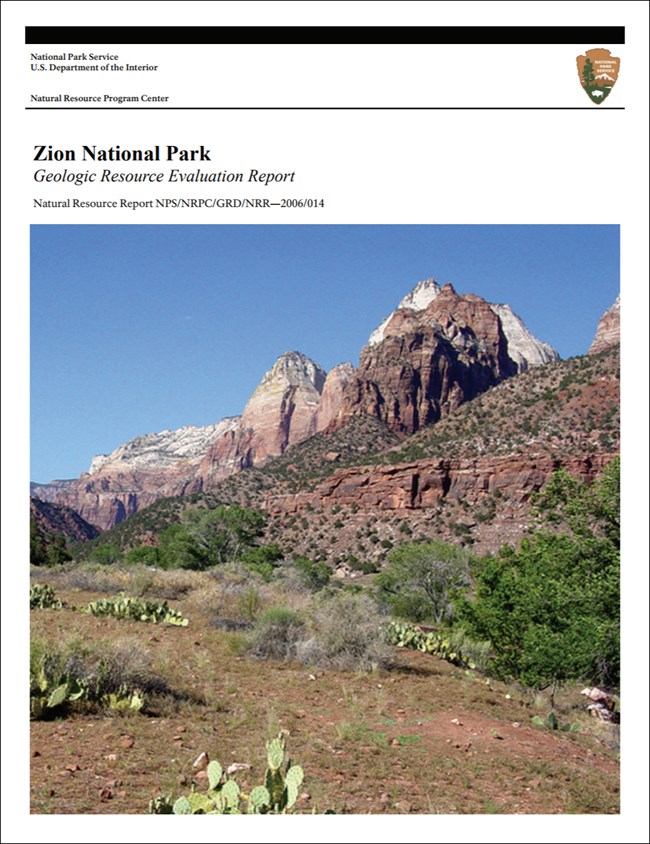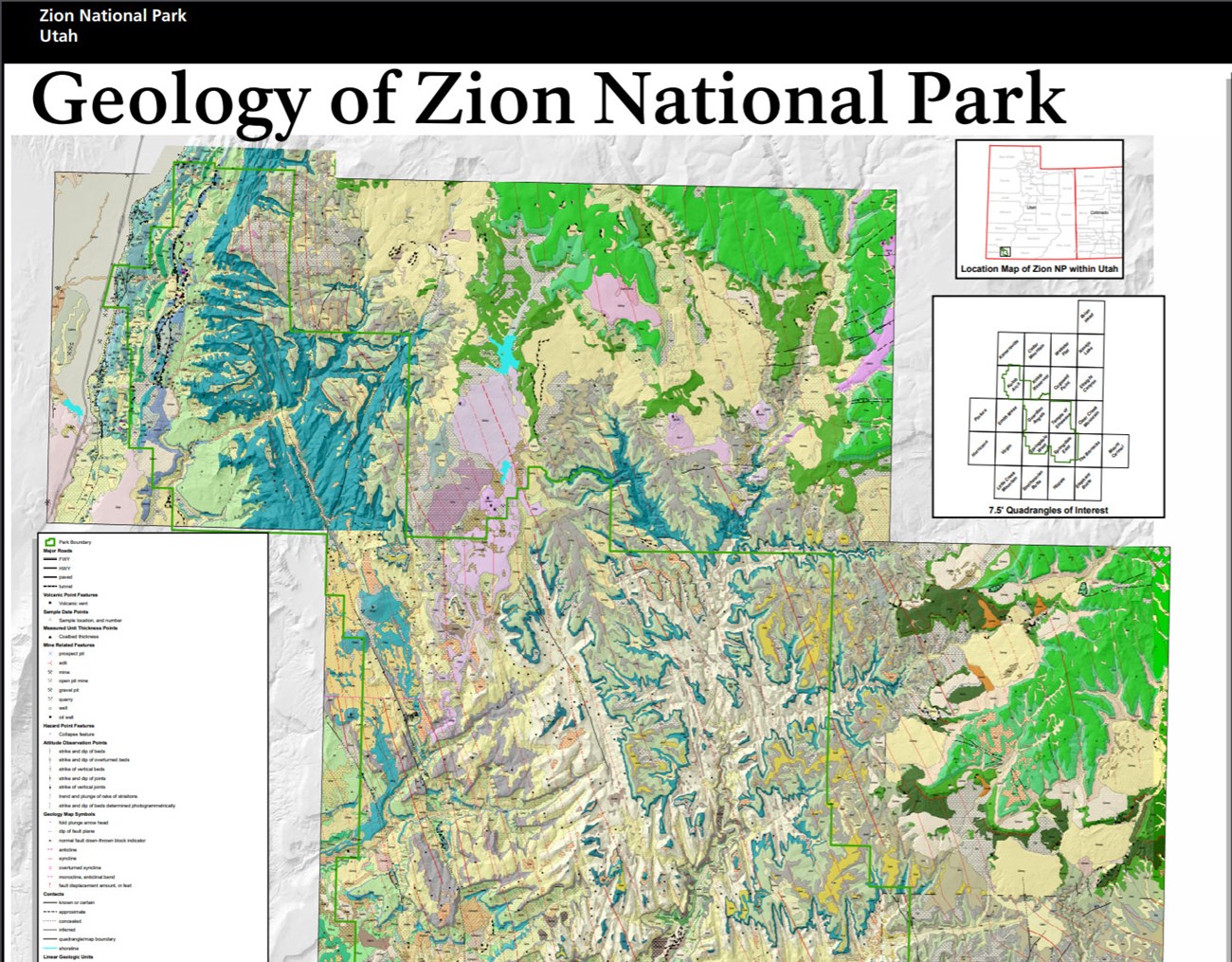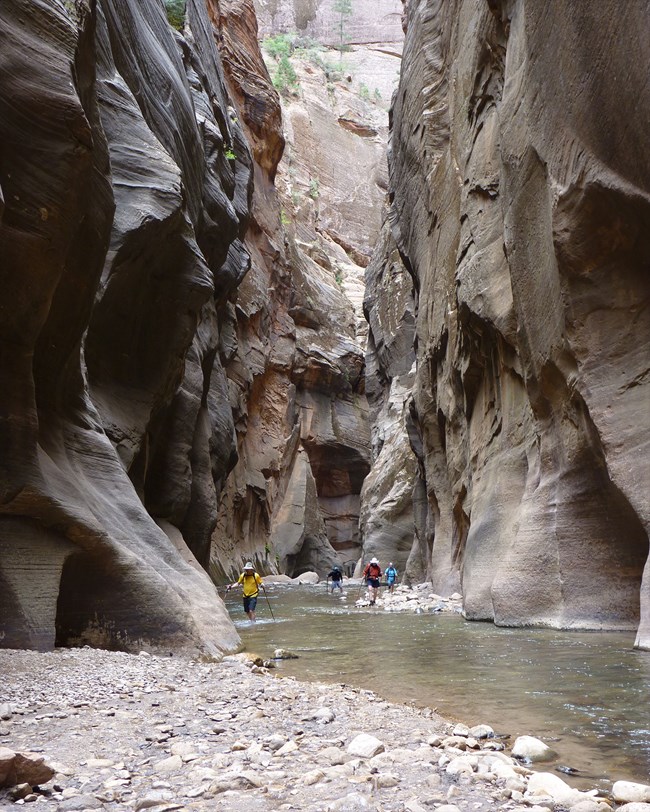Last updated: July 18, 2024
Article
NPS Geodiversity Atlas—Zion National Park, Utah
Geodiversity refers to the full variety of natural geologic (rocks, minerals, sediments, fossils, landforms, and physical processes) and soil resources and processes that occur in the park. A product of the Geologic Resources Inventory, the NPS Geodiversity Atlas delivers information in support of education, Geoconservation, and integrated management of living (biotic) and non-living (abiotic) components of the ecosystem.

Introduction
Zion National Park (ZION) is located in the semi-arid desert along the edge of the Colorado Plateau in Iron, Kane, and Washington Counties, southwestern Utah. ZION was established as a national park November 19, 1919 and encompasses 59,585 hectares (147,237 acres) of landscape decorated with plateaus, terraces, benches, shelves, monoliths, and canyons. ZION is home to Kolob Arch, the second largest arch in the U.S. with a span measuring 87.5 m (287 ft), a window height of 101 m (330 ft), and a thickness of 24 m (80 ft) (Graham 2006c). Zion Canyon contains narrow, sheer cliffs incised by the Virgin River that rise 610 m (2,000 ft) above the canyon floor. The canyon contains a myriad of geologic features that include blind arches, alcoves, hanging valleys, and waterfalls.
Geologic Setting
The colorful strata of Zion National Park record changing environmental conditions spanning 275 million years (Graham 2006c). Geologic exposures in ZION are primarily Mesozoic in age but include a range of units from the Permian to the Quaternary. Permian rocks include the Toroweap and Kaibab Formations. The long list of Mesozoic units includes the Moenkopi, Chinle, Moenave, and Kayenta Formations, Navajo Sandstone, Temple Cap Sandstone, Carmel, Cedar Mountain, and Naturita (formerly the Dakota Sandstone) Formations, Tropic Shale, and the Straight Cliffs Formation. Cenozoic rocks that cap the older sedimentary sequences include the Claron Formation and younger volcanic flows. The most abundant rock in ZION is sandstone, which makes up most of the benches, terraces, shelves, and vertical canyon walls of the park. There are various fossils, including vertebrate trace fossils (tracks) in the park.
Geologic Features and Processes
The geologic landscape of Zion is a fundamental resource of the park and a primary reason for its establishment in 1909. The park's geologic features and landforms have been studied by numerous geologists for more than 150 years. Biek et al. (2010) suggest 24 classic or iconic geologic features in the park including: Crater Hill lava flow and dam, Sentinel Landslide and Lake, Kolob Terrace, Hop Valley and landslide dam, Checkerboard Mesa, Zion Narrows, the Subway, other Slot Canyons, slickrock and joint-controlled canyons in Pine Creek and Clear Creek, the North Creek inverted valley, Double Arch Alcove, Kolob Arch, the Hurricane Fault Zone, and the Kolob Canyons.
Geologic strata and features found in the park have been the focus of scientific investigation since the pioneering work of John Wesley Powell in 1871 and Clarance Dutton in his Tertiary History of the Grand Canyon District by in 1882. Since then, over 130 scientific articles have been written on the geology of the park or closely related features.
Landforms
Zion National Park “is an extraordinary example of canyon erosion,” preserving a myriad of deep vertical-walled canyons that are bounded by the highest sandstone cliffs on earth. The primary cliff-forming layer is the Navajo sandstone, a remnant of the largest sand dune desert known to have ever existed on the planet containing 14,000 to 34,000 cubic miles of sand. The Navajo sandstone reaches its thickest beds in the vicinity of Zion NP, exceeding 2,000 feet. Deposition in wind-blown dunes during the Jurassic period is preserved in prominent cross-beds that are prominently displayed within the Navajo sandstone exposures. The sandstone was once a uniform deep salmon red, but in large areas has been leached in irregular patterns to shades of pink and yellow and approaching a pure white in the highest sections. When this rainbow of color is overlaid with streaks of dark desert varnish, and the ever-changing patterns of sun and cloud, visitors are treated to a resplendent array of color.
The Navajo sandstone is sandwiched within a stack of sedimentary strata that is over 7,000 feet thick in the park, representing a period of deposition from the early Permian Kaibab limestone to the Jurassic Carmel formation. Each of these layers, differing in color, thickness and resistance to erosion contributes to the color and form of the Zion landscape.
Rate of Erosion
The landscape of Zion is experiencing a spectacular sustained rate of erosion, down-cutting 1,300 feet in the past 1 million years. This high rate is the result of a location on the western margin of the Colorado Plateau, where it is rapidly rising relative to the Basin and Range province immediately west, and the linkage of the Colorado River system to the sea only about 4.5 million years. The rapid rate of down cutting sustains the high cliffs and the cutting of deep narrow slot canyons. The instability inherent in deeply incised, but relatively weak rocks has resulted in numerous examples of landslide dams in the canyons.
Joint-controlled Canyons
The carving of canyons in the Navajo Sandstone is strongly controlled by joints of weakness in the rock caused by relaxation of forces that once compressed the rock. Numerous canyons follow the straight joints that are roughly parallel and a uniform distance apart and perpendicular to the original compression of the rock.
Paleontological Resources
The paleontological resources of Zion National Park are recognized as rare, scientifically significant and have been the focus of recent scientific investigations. Paleontological resources are specifically referenced in the 1918 Presidential Proclamation (Pres. Proc 1435 - 40 Stat. 1760) as "...fossiliferous deposits of unusual nature…" The fossil record preserved at Zion spans from the Late Paleozoic through most of the Mesozoic. The oldest fossils include marine invertebrates documented from Permian Kaibab Formation Limestone. The Mesozoic sequences represent both marine and terrestrial deposits which contain a diversity of invertebrate, vertebrate, plant and trace fossils. Fossil vertebrate tracks from the Moenkopi Formation within Zion represent some of the oldest Mesozoic vertebrate tracks in North America. Other fossil vertebrate tracks and trackways, including those associated with early dinosaurs, are extremely abundant and well preserved in the park.
All NPS fossil resources are protected under the Paleontological Resources Preservation Act of 2009 (Public Law 111-11, Title VI, Subtitle D; 16 U.S.C. §§ 470aaa - 470aaa-11).
Volcanoes and Volcanic Processes
Volcanic processes in and around Zion National Park have created spectacular geologic textbook examples of “inverted topography.” Twelve times over the last 1.5 million years, basaltic lava flows have flowed over the landscape and down the Virgin River or its tributaries, and have blocked the drainage and many tributaries. Today, in some locations these igneous rocks stand out in higher relief creating this inverted topography, demonstrating both the differing durability of the hard basalt and the surrounding soft sedimentary strata, and the exceptionally high rate of erosion. The Crater Hill lava flow in the park is one such example emanating from Crater Hill cinder cone in the southwestern corner of the park, and damming both the Virgin River and Coalpits Wash about 300,000 years ago. Parts of six separate lava flows are fond within the park representing two major source areas.
Soils
All soils in the park can be described as young, with soil horizons poorly developed. Some soils in the park present problems for structures and are classified as expansive soils and collapsing soils, and others may be subject to piping, excessive erosion and liquefaction under certain conditions. In the lower end of Zion Canyon several tracts which had been used for farming before being acquired by the park, have a history of soil disturbance and are currently infested with invasive weeds.
Regional Geology
Zion is located at the western margin of the Colorado Plateaus Province where it joins the Basin and Range province. It is an ideal location to observe the difference between sedimentary strata of the plateau that are mostly flat, only slightly folded and intact over great distances, with the strata in the basin and range that are broken by large faults at regular intervals, steeply tilted, and off set across faults by many tens of thousands of feet. This location is also significant because the lower elevations of the basin and range provide energy for rivers to cut deep canyons into the rocks of the plateau. Movement on the fault continues in the present time.
The Hurricane Fault that marks the most obvious divide between the provinces passes through the Kolob Canyons district of the park. Its location is made obvious by the escarpment of the Hurricane Cliffs where the fault is offset by 4,000 to 5,000 feet. The Hurricane Fault has been a major divide between geologic provinces since the late Cretaceous period.
Maps and Reports
- Scoping summaries are records of scoping meetings where NPS staff and local geologists determined the park’s geologic mapping plan and what content should be included in the report.
- Digital geologic maps include files for viewing in GIS software, a guide to using the data, and a document with ancillary map information. Newer products also include data viewable in Google Earth and online map services.
- Reports use the maps to discuss the park’s setting and significance, notable geologic features and processes, geologic resource management issues, and geologic history.
- Posters are a static view of the GIS data in PDF format. Newer posters include aerial imagery or shaded relief and other park information. They are also included with the reports.
- Projects list basic information about the program and all products available for a park.
Source: NPS DataStore Saved Search 3208. To search for additional information, visit the NPS DataStore.
A NPS Soil Resources Inventory project has been started for Zion National Park and can be found on the NPS Data Store.
Source: NPS DataStore Saved Search 3233. To search for additional information, visit the NPS DataStore.
Related Articles
Zion National Park
National Park Service Geodiversity Atlas
The servicewide Geodiversity Atlas provides information on geoheritage and geodiversity resources and values within the National Park System. This information supports science-based geoconservation and interpretation in the NPS, as well as STEM education in schools, museums, and field camps. The NPS Geologic Resources Division and many parks work with National and International geoconservation communities to ensure that NPS abiotic resources are managed using the highest standards and best practices available.


